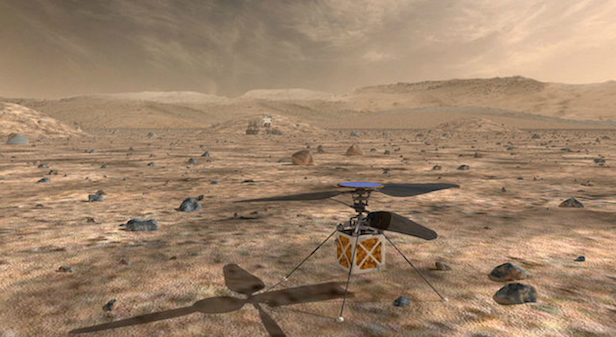NASA will send a helicopter to Mars!
On board NASA’s Mars 2020 rover will be a helicopter the size of a softball which will provide the first-ever technological demonstration of aircraft analysis on Mars

NASA’s Mars Helicopter will demonstrate the potential for heavier-than-air vehicles on the Red Planet. Image credit: NASA/JPL-Caltech
NASA will explore Mars in a way no other mission has done before when the Mars Helicopter reaches the Red Planet along with its companion, the Mars 2020 rover. Both of these vehicles are scheduled to launch in July 2020, and this small, autonomous rotorcraft will test the viability of heavier-than-air vehicles on Mars.
“NASA has a proud history of firsts,” says NASA Administrator Jim Bridenstine. “The idea of a helicopter flying the skies of another planet is thrilling. The Mars Helicopter holds much promise for our future science, discovery and exploration missions to Mars.”
United States Representative John Culberson of Texas resonates with Bridenstine’s acknowledgement of the United States’ continuation to be the first country to undergo unique adventures. “It’s fitting that the United States of America is the first nation in history to fly the first heavier-than-air craft on another world,” says Culberson. “This exciting and visionary achievement will inspire young people all over the United States to become scientists and engineers, paving the way for even greater discoveries in the future.”
This concept began in August 2013 as a technology development project at NASA’s Jet Propulsion Laboratory (JPL). After four years of designing, testing and redesigning, the final Mars Helicopter design weighs in at just 1.8 kilograms (four pounds), its overall size is roughly the same size as a softball and its twin, counter-rotating blades will spin at a rate of 3,000rpm – about 10-times the rate of a helicopter on Earth.
“Exploring the Red Planet with NASA’s Mars Helicopter exemplifies a successful marriage of science and technology innovation and is a unique opportunity to advance Mars exploration for the future,” says Thomas Zurbuchen, Associate Administrator for NASA’s Science Mission Directorate at the agency headquarters in Washington. “After the Wright Brothers proved 117 years ago that powered, sustained and controlled flight was possible here on Earth, another group of American pioneers may prove the same can be done on another world.”
Surviving the Martian surface requires special qualities from the helicopter, some of which include built-in solar cells in order to charge its lithium-ion batteries. There is also a heating mechanism within the helicopter to keep it warm for the harsh Martian winters. However, before all of this becomes useful, the helicopter first needs to get to Mars. To achieve this first step the helicopter will be attached to the belly pan of NASA’s Mars 2020 rover.
“The altitude record for a helicopter flying here on Earth is about 40,000 feet [12,000 metres]. The atmosphere of Mars is only one per cent that of Earth, so when our helicopter is on the Martian surface it’s already at the Earth equivalent of 100,000 feet [30,500 metres] up,” says Mimi Aung, Mars Helicopter project manager at JPL. “To make it fly at that low atmospheric density we had to scrutinise everything, make it as light as possible while being as strong and as powerful as it can possibly be.”
Once Mars 2020 has safely landed and found a suitable location to deploy the helicopter it will then be placed down on the ground. The rover will then retreat to a safe distance, where it can relay commands. After the batteries are charged and many tests have been performed, controllers on Earth will finally command the Mars Helicopter to undergo its first-ever autonomous flight into the history books.
“We don’t have a pilot and Earth will be several light minutes away, so there is no way to joystick this mission in real time,” says Aung. “Instead, we have an autonomous capability that will be able to receive and interpret commands from the ground, and then fly the mission on its own.”
There is a 30-day flight test campaign that aims to fly the helicopter up to five times. In these flights, the flight distances will increase incrementally, up to a few hundred metres at a time, and the durations for each flight will increase, lasting as long as 90 seconds. The plan for the first flight is the helicopter will make a vertical climb to three metres (ten feet) and it will hover for about 30 seconds.
There are great benefits to this project as a technological demonstration, but it doesn’t come without its potential issues. If the helicopter doesn’t work, the Mars 2020 rover will not be impacted. If it does work, it could prove vital for the future of using helicopters as low-flying scouts and aerial vehicles on other planets, as they can reach locations not possible by ground travel.
“The ability to see clearly what lies beyond the next hill is crucial for future explorers,” says Zurbuchen. “We already have great views of Mars from the surface as well as from orbit. With the added dimension of a bird’s-eye view from a ‘marscopter’ we can only imagine what future missions will achieve.”
Mars 2020 will launch on a United Launch Alliance (ULA) Atlas V rocket from Space Launch Complex 41 at Cape Canaveral Air Force Station in Florida, and is expected to reach Mars in February 2021. This rover will conduct important geological assessments of its landing site on Mars, including the analysis of the habitability of the site, any signs of ancient Martian life and assessing natural resources, as well as hazards for future human exploration.
Keep up to date with the latest reviews in All About Space – available every month for just £4.99. Alternatively you can subscribe here for a fraction of the price!




